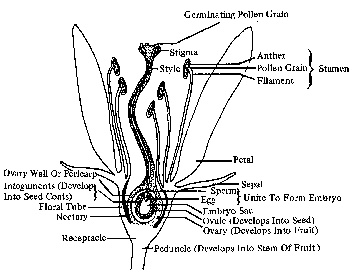What Does The Anther And Filament Makeup What Is The Main Function Of The Circulatory System
Information Sheet 9
Parts of Flowers
Flowers are beautiful to us, but for the constitute they serve a critical function. Flowers are how plants produce seeds to reproduce. In many cases, the blossom contains male person and female parts, roughly equivalent to the male and female person sexes of animals. The male person parts of the bloom are called the stamens and are made upward of the anther at the top and the stalk or filament that supports the anther. The female elements are collectively chosen the pistil. The top of the pistil is called the stigma, which is a glutinous surface receptive to pollen. The bottom of the pistil contains the ovary and the narrowed region in between is chosen the style. The male contribution or pollen is produced in the anther, and seeds develop in the ovary. Many of the fruits we eat are the thickened ovary walls surrounding the seeds.
Non merely does the bloom contain the sexual parts necessary for reproduction, they are besides like flashy roadside billboards advertising a rich supply of nectar and pollen gear up and waiting for pollinating insects and other creatures.
That is the bargain offered. Flowers merchandise rewards (in the class of sugary nectar and pollen) in return for the service that insects and other pollinators perform. Pollination is simply the transfer of pollen grains from an anther to a stigma. Fertilization occurs much later when the pollen grains germinate on the stigma and send down a pollen tube which releases the sex cells to fertilize the ovules. After fertilization, the ovules become the seeds, and the ovary wall becomes the fruit.
The sexual nature of flowers and the role of the many forms, colors and scents in attracting pollinators was discovered in 1759 past Arthur Dobbs.
Angiosperms. Flowering plants that have a condensed shoot tip specialized for reproduction.
Anthers. The bright yellow sacs that produce and contain the pollen grains.
Composites. Flowers such as daisies, sunflowers and their relatives that are made up of lots of tiny flowers but look but like a single flower.
Filament. The thin stem that supports the anther in the male portion of the flower.
Gametes. The sex cells of a bloom, both male and female. The gametes are porduced within the anthers of the male office and the ovary of the female part of the flower.
Gymnosperms. Plants that produce seeds without flowers, such as conifers.
Nectar. A sugary liquid reward for pollinators that is produced by the nectaries.
Nectaries. The tissue at the base of a flower (or elsewhere) that secrete nectar. Some plants, such equally cotton, have nectaries on the leaves or stems. These are called extrafloral nectaries, and may serve to concenter benign insects. An instance is the extrafloral nectaries of peonies (a bloom) that attract ants that in turn protect the unopened flower buds from caterpillars.
Ovary. The base of operations of the female portion of the flower containing the ovules which become seeds.
Perfect flower. Perfect flowers contain both the male parts and female parts within a single flower structure.
Petals. The colorful, thin structures that surround the sexual parts of the flower. Not but concenter pollinators, but also protect the pistil and stamen. May also produce a scent.
Pollen grains. The powdery particles that incorporate the male sex cells (gametes). Also a nutritious, protein-rich food for bees.
Pollination. The act of transferring pollen from the anther to the stigma. The pollen may be carried by the current of air or water, merely is usually transported by a go-between insect, bird or bat.
Sepals. Ordinarily greenish, leaflike structures that protect the bud prior to opening.
Stamen. Male part of bloom consisting of anther and filament.
Stigma. Sticky surface where the pollen lands and germinates.

Return to homepage
Source: https://cals.arizona.edu/pubs/insects/ahb/inf9.html
Posted by: blankenshiphoure1985.blogspot.com

0 Response to "What Does The Anther And Filament Makeup What Is The Main Function Of The Circulatory System"
Post a Comment